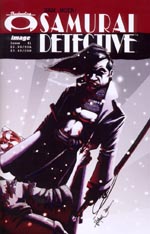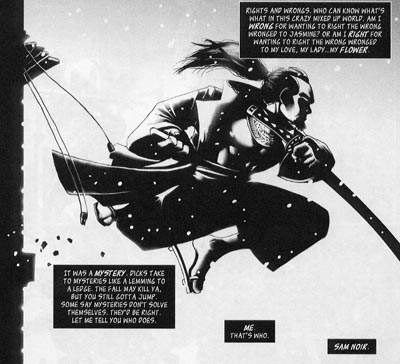 Written by Manny Trembley and Eric A. Anderson
Written by Manny Trembley and Eric A. Anderson
Art by Manny Trembley
24 pages, black and white
Published by Image Comics
With a title like Sam Noir: Samurai Detective one would almost automatically assume that the comic is going to be a comedy. The merging of samurai culture with pulp detective fiction, after all, seems like something you can’t succeed with unless there’s a touch of humor involved. The more I read of Sam Noir: Samurai Detective, I began to have a nagging doubt. Could it be that Manny Trembley and Eric A. Anderson are taking the concept 100% seriously?
 Sam Noir was hired to watch someone—in this case, a woman named Jasmine. What begins as a months-long stake out becomes more, though, as Sam found himself increasingly attracted to her. Then Jasmine came into his office, asking for help before promptly getting killed. And no one kills a dame in Sam Noir’s office.
Sam Noir was hired to watch someone—in this case, a woman named Jasmine. What begins as a months-long stake out becomes more, though, as Sam found himself increasingly attracted to her. Then Jasmine came into his office, asking for help before promptly getting killed. And no one kills a dame in Sam Noir’s office.
I was at the end of the second page of Sam Noir: Samurai Detective #1 when I started wincing. It was a narration box that had triggered the reaction, one which read, “I just did what I do. I’m a detective. I detect things.” And it was right about then that I began to have a sinking suspicion that this wasn’t supposed to be funny. It’s difficult in a situation like this because there are two possible answers to the question you’ve just asked yourself. Is the book supposed to be serious but ends up making the reader cringe? Or is the book supposed to be funny but just isn’t succeeding?
There’s no easy answer, of course. In the end I had to go with the idea that Trembley and Anderson are taking this concept completely seriously. In the end, it’s because almost all of the offending passages are pieces of Sam Noir’s narration, a series of clichéd gumshoe mystery phrases which are an amalgamation of every bad and stereotypical piece of fiction in the genre. Because it’s almost entirely confined to this one character, though, it gives the reader the impression that this isn’t an over-the-top book where everyone is taken to an extreme level of stereotype, but instead it’s a piece of characterization for Sam Noir. It’s ultimately very unfortunate, because if you stop reading Sam’s narration entirely and focus on just the art and the actual spoken dialogue it’s not a bad book. It’s all over, though, the second you read a gem like, “Plans are like rice paper. Good for blocking sunlight. But apply a bit of pressure and you rip right through it.” In the end, one just feels a little embarrassed reading the comic.
 Trembley’s art, on the other hand, is certainly more interesting. It’s composed almost entirely of a series of soft shadows, giving the book a strange sort of gentleness which meshes well with the violent events that it’s portraying. Instead of the book being a visual bloodbath everything feels slightly disconnected to the reader, an elegant creation that unfolds with grace and ease. It’s not perfect, sometimes looking a little too silly; Sam Noir jumping out of his office window looks almost like it’s missing a “boing!” sound-effect and the effect is to laugh instead of gasp. There are also some strange hiccups in terms of actual physics; on the previous page, the negative white-on-black shadow of the throwing stars hitting Jasmine’s body looks fantastic until you realize that with the way her hair is moving, she’s somehow falling backwards even as projectiles hit her from behind. It’s a shame because the art is by far the strongest thing about the book, but little glitches like this keep pulling the reader back out of its pages.
Trembley’s art, on the other hand, is certainly more interesting. It’s composed almost entirely of a series of soft shadows, giving the book a strange sort of gentleness which meshes well with the violent events that it’s portraying. Instead of the book being a visual bloodbath everything feels slightly disconnected to the reader, an elegant creation that unfolds with grace and ease. It’s not perfect, sometimes looking a little too silly; Sam Noir jumping out of his office window looks almost like it’s missing a “boing!” sound-effect and the effect is to laugh instead of gasp. There are also some strange hiccups in terms of actual physics; on the previous page, the negative white-on-black shadow of the throwing stars hitting Jasmine’s body looks fantastic until you realize that with the way her hair is moving, she’s somehow falling backwards even as projectiles hit her from behind. It’s a shame because the art is by far the strongest thing about the book, but little glitches like this keep pulling the reader back out of its pages.
It could be that I’ve completely misread Sam Noir: Samurai Detective #1, but Trembley and Anderson’s comic seems to be custom-made for that reaction. Not a successful comedy or a drama, ultimately the question becomes which sort of misstep it is. If you’re attracted to the art, using a black magic-marker to block out all of the narration boxes (which are conveniently black backgrounds with white text) will go a long way into making Sam Noir: Samurai Detective palatable. In its current published state, though, it just doesn’t really succeed on any level.
